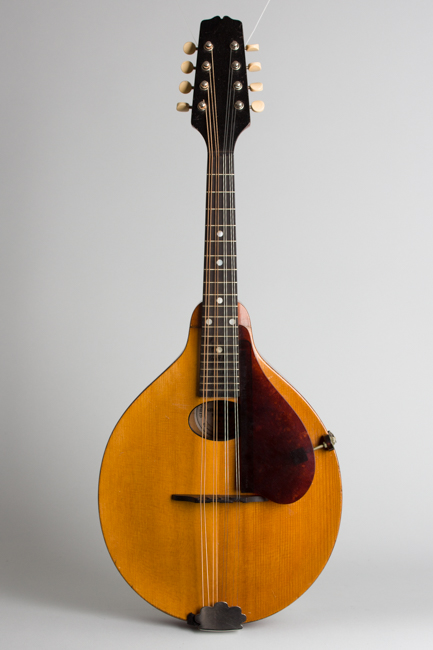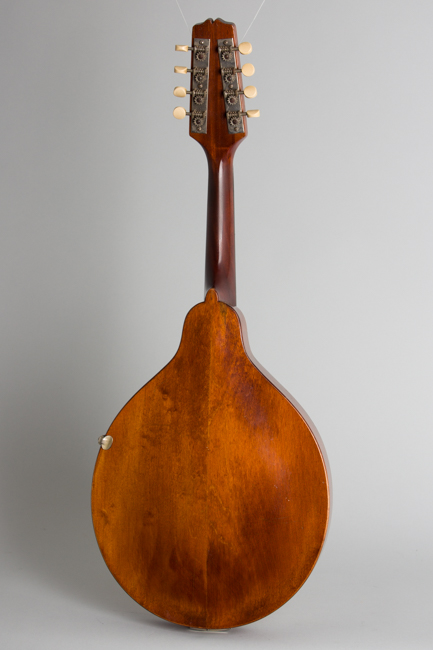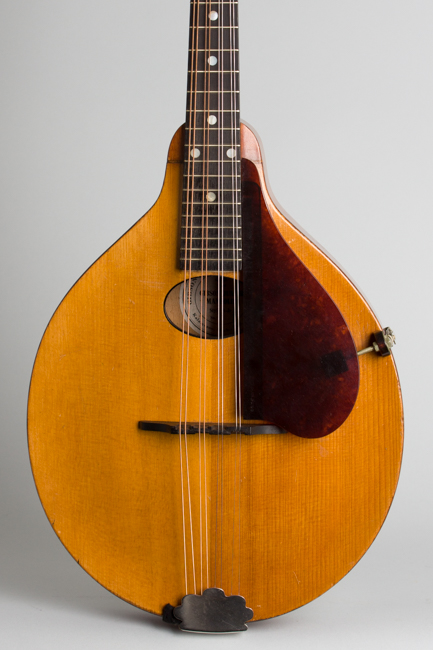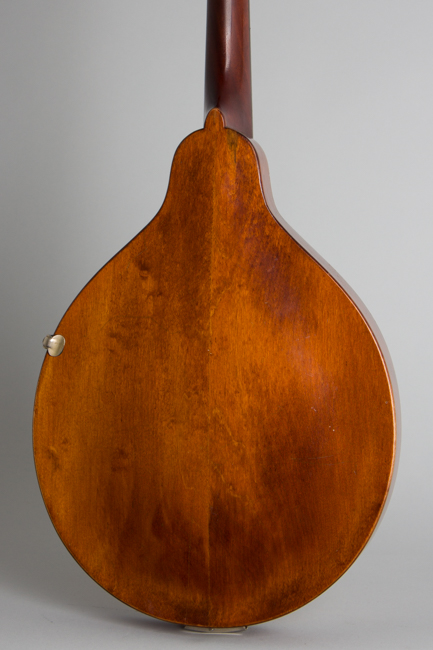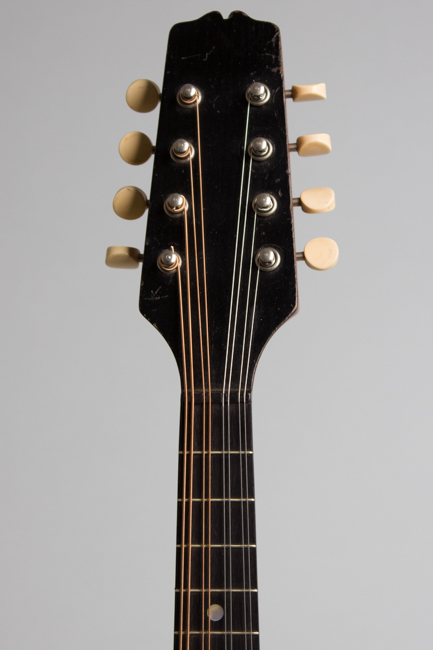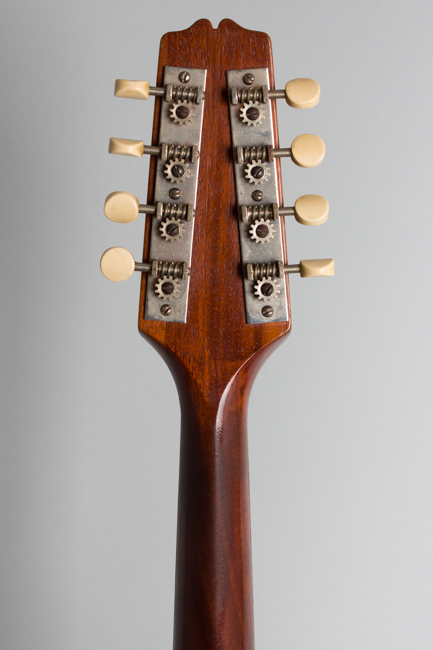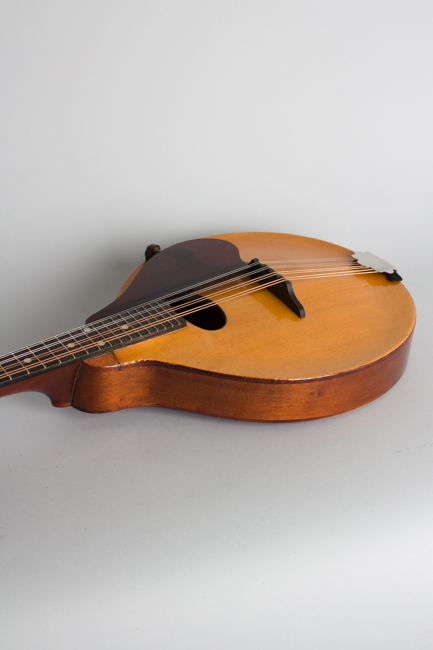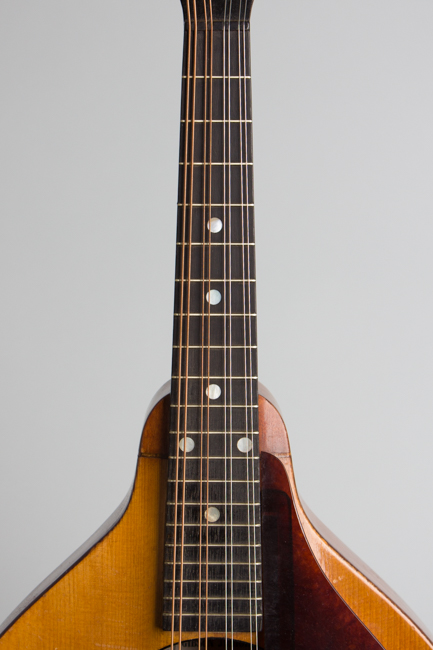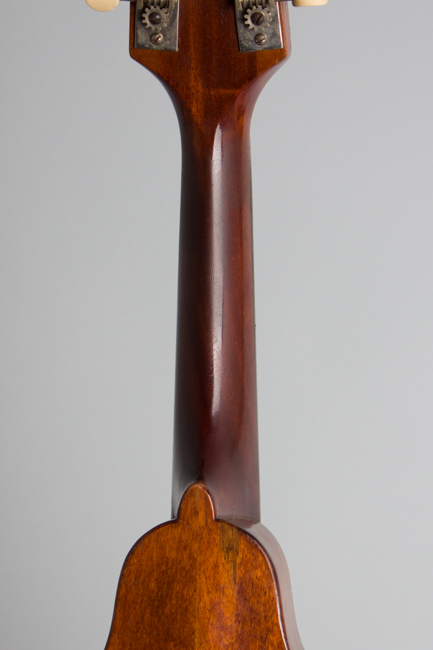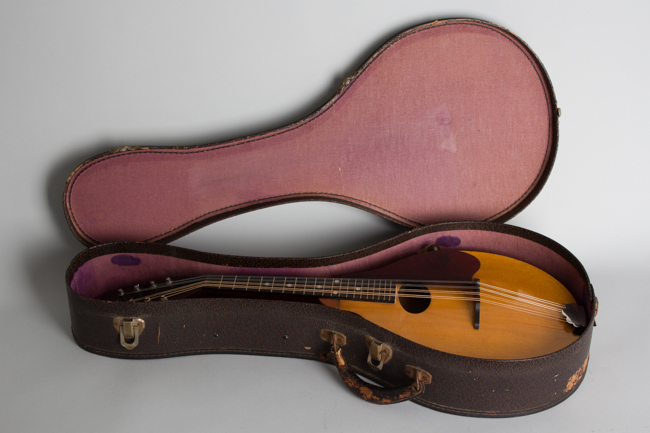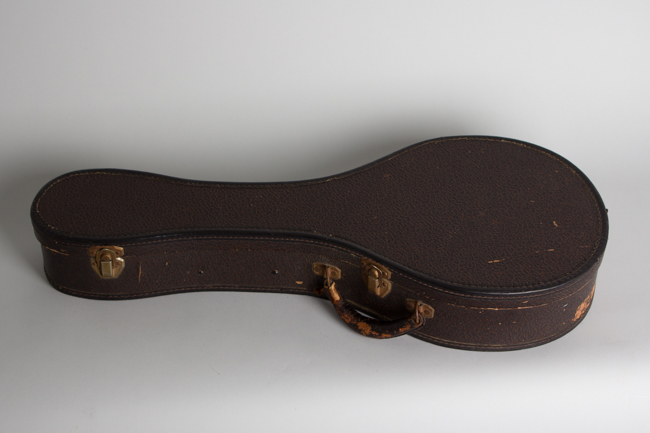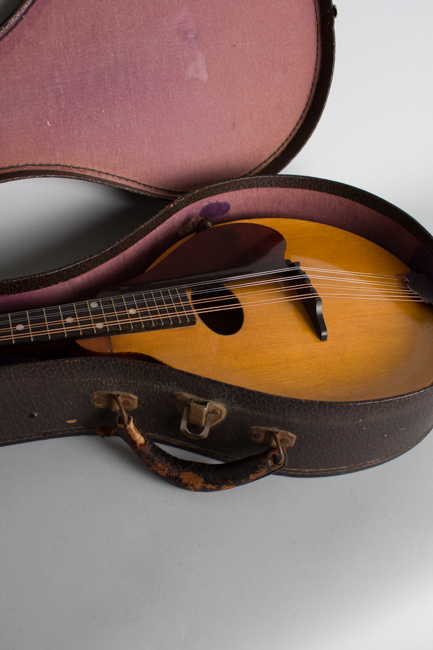Gibson A-Junior Snakehead Carved Top Mandolin (1924)
This item has been sold.
Item # 10206
Prices subject to change without notice.
Gibson A-Junior Snakehead Model Carved Top Mandolin (1924), made in Kalamazoo, Michigan, serial # 76678, natural laquer re- finish, birch back and sides, spruce top; mahogany neck with ebony fingrboard, original black chipboard case.
This is a great-playing and sounding original A-Junior mandolin from mid/late 1924, the final months of the "Loar era" at Gibson. It appears to have had the body re-finished from brown stain to a somewhat more attractive natural when fairly new, so it is not all original but still lovely example of Gibson's mandolin craftsmanship was built just before the company's focus shifted to banjos and then guitars. "Snakeheads" are generally considered the best-sounding roundhole "A" style mandolins ever made, revered for their unmatched tone and projection compared to earlier or later A-models. Although the A-Junior was the lowest priced model offered this one certainly bears this out.
"Snakehead" instruments are named for their Loar-designed peghead that angles inward towards the tip, a feature inexplicably abandoned by Gibson some time after he left the company. While this basic A-Junior lacks some of the other advanced features of the era (it does not have an adjustable truss rod or height-adjustable bridge) it does sport the very slim neck profile and sleeker peghead shape. The top has a thin ambered natural finish which looks period but not Gibson work, the back and sides are also refinished but the neck remains original. We find this somewhat more attractive than the nondescript brown stain the Junior models were finished with, it is period work if not technically correct. There is no binding at all, but the same tortoise celluloid pickguard as the higher grade models is present, secured by the transitional side bracket clamp. The tailpiece has a simple "clamshell" cover plate and the tuners are plain openback strips.
Lloyd Loar's tenure as acoustic engineer at Gibson has become so mythical that separating fact from fiction is difficult. The mandolin family instruments made during the period of his employment were refined and improved from earlier patterns and are the most perfectly realized in Gibson's history. They have become the template for most similar instruments since, ever more sought-after by discerning players. Even this most basic "A" model has sonic and playing improvements benefitting from "Master Loar's" input still evident today, nearly 100 years on.
Overall length is 25 3/4 in. (65.4 cm.), 10 1/4 in. (26 cm.) wide, and 1 7/8 in. (4.8 cm.) in depth, measured at side of rim. Scale length is 14 in. (356 mm.). Width of nut is 1 3/16 in. (30 mm.).
As noted this nearly 100 year old mandolin looks to have been partially refinished very early on but has seen comparatively little use since then, remaining an excellent player with a lively sound. The original varnish on the back of the neck shows some loss down to the wood from play. The natural finish on the body has a lovely aged patina with just typical fairly minor dings, dents, and scrapes overall, with the top remaining relatively clean and free of the typical pick wear. There is one repaired crack on the lower back, glued up but not finished over.
All hardware remains original and complete including the tuners, tailpiece and pickguard. The neck has remained true for 97 years and the original frets have only very minor wear making this an excellent player. While not 100% original this is still a lovely player's example of Gibson's plainest Loar-period A Model, complete in its original chipboard case that is nicely preserved as well. Overall Excellent Condition.
This is a great-playing and sounding original A-Junior mandolin from mid/late 1924, the final months of the "Loar era" at Gibson. It appears to have had the body re-finished from brown stain to a somewhat more attractive natural when fairly new, so it is not all original but still lovely example of Gibson's mandolin craftsmanship was built just before the company's focus shifted to banjos and then guitars. "Snakeheads" are generally considered the best-sounding roundhole "A" style mandolins ever made, revered for their unmatched tone and projection compared to earlier or later A-models. Although the A-Junior was the lowest priced model offered this one certainly bears this out.
"Snakehead" instruments are named for their Loar-designed peghead that angles inward towards the tip, a feature inexplicably abandoned by Gibson some time after he left the company. While this basic A-Junior lacks some of the other advanced features of the era (it does not have an adjustable truss rod or height-adjustable bridge) it does sport the very slim neck profile and sleeker peghead shape. The top has a thin ambered natural finish which looks period but not Gibson work, the back and sides are also refinished but the neck remains original. We find this somewhat more attractive than the nondescript brown stain the Junior models were finished with, it is period work if not technically correct. There is no binding at all, but the same tortoise celluloid pickguard as the higher grade models is present, secured by the transitional side bracket clamp. The tailpiece has a simple "clamshell" cover plate and the tuners are plain openback strips.
Lloyd Loar's tenure as acoustic engineer at Gibson has become so mythical that separating fact from fiction is difficult. The mandolin family instruments made during the period of his employment were refined and improved from earlier patterns and are the most perfectly realized in Gibson's history. They have become the template for most similar instruments since, ever more sought-after by discerning players. Even this most basic "A" model has sonic and playing improvements benefitting from "Master Loar's" input still evident today, nearly 100 years on.
Overall length is 25 3/4 in. (65.4 cm.), 10 1/4 in. (26 cm.) wide, and 1 7/8 in. (4.8 cm.) in depth, measured at side of rim. Scale length is 14 in. (356 mm.). Width of nut is 1 3/16 in. (30 mm.).
As noted this nearly 100 year old mandolin looks to have been partially refinished very early on but has seen comparatively little use since then, remaining an excellent player with a lively sound. The original varnish on the back of the neck shows some loss down to the wood from play. The natural finish on the body has a lovely aged patina with just typical fairly minor dings, dents, and scrapes overall, with the top remaining relatively clean and free of the typical pick wear. There is one repaired crack on the lower back, glued up but not finished over.
All hardware remains original and complete including the tuners, tailpiece and pickguard. The neck has remained true for 97 years and the original frets have only very minor wear making this an excellent player. While not 100% original this is still a lovely player's example of Gibson's plainest Loar-period A Model, complete in its original chipboard case that is nicely preserved as well. Overall Excellent Condition.
